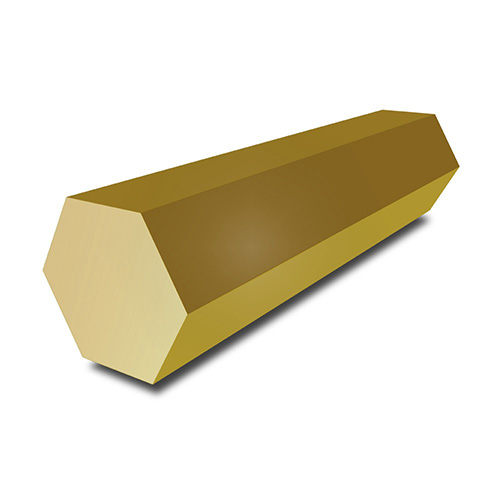- Composition: Composed of 70% copper and 30% zinc.
- Characteristics: Offers excellent machinability, good corrosion resistance, and is often used for general-purpose applications.
- Applications:Typically used for fasteners, electrical components, and decorative items.
Brass Hexogonal Bar

Brass Hexogonal Bar
Precision, Strength, and Versatility
Description
Brass hexagonal bars, commonly known as brass hex bars, are six-sided rods made from an alloy of copper and zinc. These bars combine strength, formability, corrosion resistance, and aesthetic appeal, making them an essential material in various industries, particularly in mechanical and decorative applications. Brass hex bars are commonly used for custom machined parts, fasteners, and other components where precise dimensions and excellent surface finish are critical.
Key Features of Brass Hex Bar
- Corrosion Resistance:Brass offers excellent resistance to corrosion, particularly in moist or marine environments. Its ability to resist rust, tarnishing, and oxidation makes brass hex bars ideal for use in harsh conditions such as plumbing, marine, and outdoor applications.
- Superior Machinability:Brass hex bars are easy to machine and fabricate. They can be cut, drilled, tapped, and turned with precision, making them ideal for applications requiring detailed customization. Their machinability allows for the production of intricate parts with tight tolerances.
- Strength and Durability:Brass, while not as strong as some other metals like steel, offers a great balance of strength, weight, and durability. Brass hex bars provide strength in various applications without being too heavy or difficult to work with.
- Aesthetic Qualities: Brass hex bars have a naturally attractive gold-like sheen, which makes them aesthetically pleasing for decorative and high-end architectural applications. Over time, brass develops a unique patina, adding to its charm.
- Electrical and Thermal Conductivity:Brass offers good electrical and thermal conductivity, making brass hex bars suitable for electrical and heat-exchanging applications.
Popular Grades of Brass Hex Bars
-
C26000 (Cartridge Brass)
-
C36000 (Free-Cutting Brass)
-
C27000 (Muntz Metal)
-
C23000 (Red Brass)
Industries Served by Brass Flat Bars
Electrical
Brass hex bars are widely used in the manufacture of electrical components like connectors, terminals, and switches due to their electrical conductivity and corrosion resistance.
Plumbing and HVAC
With outstanding resistance to corrosion in saltwater, brass flat bars are ideal for use in marine hardware, boat fittings, and valves.
Automotive and Aerospace
Brass hex bars are used for precision components in the automotive and aerospace industries, such as fasteners, bushings, and trim.
Marine
Brass hex bars are resistant to corrosion in saltwater, making them an ideal choice for marine hardware, fittings, and components exposed to harsh conditions.
Architectural and Furniture Design:
Brass hex bars are used in decorative applications such as furniture hardware, door handles, and architectural trim due to their aesthetic qualities.
Manufacturing and Engineering
Brass hex bars are used in manufacturing machine parts, fasteners, structural components, and more in industries ranging from electronics to heavy machinery.
Sizes and Specifications of Brass Hex Bars
Standard Diameter:
- Brass hex bars are available in a range of diameters, typically from 6mm up to 150mm, with custom sizes available based on customer requirements.
Standard Lengths:
- Brass hex bars are commonly available in lengths ranging from 1 meter to 6 meters, although custom lengths can be manufactured upon request.
Finish Options:
- Mill Finish:The natural finish of the brass hex bar without any additional polishing, suitable for industrial applications.
- Polished Finish:Brass hex bars can be polished to a high sheen for decorative purposes, such as in architectural and furniture applications.
- Anodized Finish: Anodizing improves the corrosion resistance of brass and can create a uniform, shiny appearance.
Key Benefits of Brass Hex Bars
- Excellent Corrosion Resistance:
Brass hex bars are highly resistant to corrosion, making them ideal for outdoor, marine, and industrial environments exposed to moisture, chemicals, and saltwater. - Easy Machining:
Brass hex bars offer excellent machinability, allowing them to be easily turned into custom parts with precision. This makes them a popular choice for the manufacturing of intricate components and fasteners. - Attractive Appearance:
Brass has a gold-like sheen, making it a favored material for decorative and architectural elements. Over time, brass develops a natural patina that adds character and charm to its appearance. - High Strength-to-Weight Ratio:
Brass hex bars provide a good balance of strength and weight, offering durability while remaining easy to handle and fabricate. - Conductivity:
Brass hex bars have good electrical and thermal conductivity, making them suitable for use in electrical components, switches, and heat exchangers. - Recyclability:
Brass is a recyclable material, which helps reduce environmental impact. Recycled brass can be reused in manufacturing processes, making it a sustainable material option.
Conclusion
Brass hex bars are a versatile and durable material widely used in numerous industries, including electrical, plumbing, automotive, aerospace, and decorative design. With their excellent corrosion resistance, machinability, and attractive appearance, brass hex bars provide a unique combination of performance and aesthetic appeal. Whether used for precision parts, fasteners, or decorative elements, brass hex bars offer a reliable and efficient solution for a wide range of applications.
